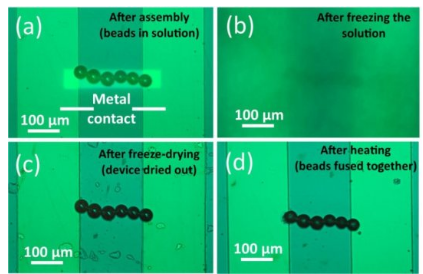By Nicole DiGiose, content editor
When it comes to producing cheaper components, let there be light! Fortunately, an international team of researchers developed a light-based manipulation method that could be used to mass-produce electronic components for smartphones, computers, and other devices. Of course, a less expensive and faster way to produce these components will make it easier — cost-wise — to connect everyday objects from clothing to house appliances to the internet, advancing the Internet of Things (IoT).

After using optoelectronic tweezers to assemble a line of solder beads, the researchers froze the liquid and reduced the pressure so the frozen liquid turned a solid into a gas, drying out the device. Next, they heated the beads to fuse them into an electrical connection. Image source: Shuailong Zhang.
According to The Optical Society (OSA) , optical traps, which use light to hold and move small objects in liquid, are a promising non-contact method for assembling electronic and optical devices. In the journal Optics Express, researchers in the Micromanipulation Research Group at the University of Glasgow, Scotland, detailed their method for using an advanced optical trapping approach known as optoelectronic tweezers to assemble electrical contacts. Thanks to an innovative freeze-drying method developed by Shuailong Zhang, a member of the research group, the liquid could be removed without disturbing the assembled components.
“The forces formed by these optoelectronic tweezers have been compared to ‘Star-Trek’-like tractor beams that can move objects through a medium with nothing touching them,” said Steven Neale , head of the Micromanipulation Research Group. “This conjures up images of assembly lines with no robotic arms. Instead, discrete components assemble themselves almost magically as they are guided by the patterns of light.”
To demonstrate the technique, the researchers assembled a pattern of tiny solder beads with an optoelectronic trap, removed the liquid, and heated the pattern to fuse the beads together, forming electrical connections. The solder beads were meant to show that in the future, such microparticles could be assembled and fused to create electrical connections.
“Optoelectronic tweezers are cost-effective and allow parallel micromanipulation of particles,” said Zhang . “In principle, we can move 10,000 beads at the same time. Combining this with our freeze-drying approach creates a very inexpensive platform that is suitable for use in mass production.”
According to the research, the new technique could offer an alternative way to make the circuit boards that connect the components found in many of today’s electronics. Currently, these types of devices are made using automated machines that pick up tiny parts, place them onto the circuit board, and solder them into place. This process requires an expensive motorized stage to position the board and a costly high-precision robotic arm to pick up and place the tiny parts onto the device. The cost of these micromanipulation systems continues to increase as the shrinking size of electronics inflates precision requirements.
“The optoelectronic tweezers and freeze-drying technique can be used to not only assemble solder beads, but also to assemble a broad range of objects such as semiconductor nanowires, carbon nanotubes, microlasers, and microLEDs,” said Zhang . “Eventually, we want to use this tool to assemble electronic components such as capacitors and resistors as well as photonic devices, such as lasers and LEDs, together in a device or system.”
After using the optoelectronic tweezers to assemble a pattern of 40-micron-diameter, commercially available solder beads, the researchers froze the liquid in the optoelectronic tweezer device and reduced the surrounding pressure to allow the frozen liquid to turn from a solid directly into a gas. This approach allowed the assembled solder beads to remain fixed in place after the liquid was removed. According to the researchers, it can be used to remove liquid used with any type of optical trap, or even traps formed with acoustic waves.
Along with assembling the solder beads into different lines, the team demonstrated parallel assembly of several beads and used the beads to form electrical connections. The solder beads exhibit a strong dielectric force, which means that they can be moved accurately and fast, allowing for very efficient assembly of structures.
Now, the researchers are working to turn their laboratory-based system into one that would combine the optoelectronic tweezer and freeze-drying process in a single unit. They’re also developing a software interface to control the generation of a light pattern based on the number of particles that need to be trapped.
Advertisement
Learn more about Electronic Products Magazine





